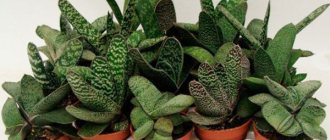The indoor azalea is a representative of the rhododendron genus and a close relative of the garden beauties - tall rhododendrons. There are several hundred species in the wild, but only two and their hybrid forms are grown at home.
The indoor azalea flower is a compact shrub 30–50 cm high with abundant and very beautiful flowering, which has made it popular among indoor plant lovers. Its flowers are lush, in shades of red, white and pink, there are varieties with lilac and two-color corollas. Azalea is also valued because it blooms in the cold season, when most other flowering plants are dormant.
Types and varieties of indoor azalea
There are two types of indoor azaleas.
Indian azalea (indica), or Sims' rhododendron (Rhododendron simsii) (1). The most popular type, it is the one that can most often be found on sale. It is an evergreen shrub with small dark green leaves with reddish pubescence. The flowers of this indoor azalea are simple or double, usually reach sizes of 3 - 5 cm or larger and are collected in round inflorescences.
Japanese azalea, or blunt rhododendron (Rhododendron obtusum) (2) . Less common. Its flowers are small compared to Indian ones and more neat in shape. Japanese azalea can also be grown as a garden plant.
As for the varieties of azaleas, they are mainly known only to collectors: in stores and shopping centers, hybrid azaleas are most often sold, which are usually called “Azalea white / pink / red” or “Azalea mix”, and sometimes simply “Azalea indica” . Azalea varieties may differ in flowering time: early winter or mid-winter - early spring. Unfortunately, it is unlikely that you will be able to find out such details when buying an azalea in a store - the characteristics of the variety (and at the same time its name) can only be found out when purchasing a plant from a collector.
The most famous of the old varieties are (3):
- Adventsglocken - a tall (45 - 50 cm) variety with single large (6 - 8 cm) raspberry-pink flowers that stay on the plant for up to 20 days;
- Vervaeneana - a tall variety with semi-double large flowers (8 - 8.5 cm) of pink color with a white border along the edges of the petals, blooms for 190 days;
- Max Schäme - tall, with double flowers with a diameter of 8 - 8.5 cm, petals of a salmon shade strongly corrugated along the edge, blooms for 130 days;
- White Niobe (Niobealba) is a tall (45 - 60 cm), spreading azalea with white double flowers with a diameter of 8 - 9 cm, blooms for 80 days;
- Schnee is a tall variety with semi-double white flowers, blooms for 130 days.
Caring for indoor azalea at home
Azalea is a capricious plant, demanding on growing conditions. This is due to the fact that in nature azaleas gravitate to cool mountain climates and certain types of soil (4).
Priming
The soil for indoor azaleas should be acidic; in neutral and alkaline soils, the plant gets sick and may die. Of the ready-packed soil mixtures, only special ones are suitable for it - for azaleas, rhododendrons, camellias and heathers.
Experienced flower growers prepare soil for azaleas on their own, but this is difficult for amateurs, and with this approach it is difficult to maintain the optimal acidity level required by the plant.
Indian azalea. Photo: pixabay.com
Lighting
Indoor azaleas prefer bright, diffused light; in direct sun, their growth is inhibited, and leaves and flowers can get burned. It is possible to grow indoor azaleas in partial shade, but in winter, during the period of bud formation and flowering, azaleas may require additional lighting with a phytolamp.
Temperature
One of the main difficulties in caring for an indoor azalea is providing it with a suitable temperature regime. Azaleas are cold-loving, the optimal temperature for them outside the flowering period is 15 - 18 ° C, and lush flowering is often stimulated by a decrease in temperature during the period of bud formation to 10 - 12 ° C.
Indoor azalea does not tolerate summer heat well; the upper limit it can tolerate is about 20 °C. Moreover, sudden changes in temperature also harm the plant, especially at the moment of formation of buds - in such conditions they can fall off and there will be no flowering.
Being in a draft is also harmful for azaleas, but periodic ventilation of the premises is beneficial for it. When growing azaleas in a city apartment, it is recommended to place them in the summer on a balcony oriented north or west, but in no case to the south. In winter, it is better to keep the plant as far as possible from heating devices; acceptable conditions can be provided for it on an insulated glazed balcony with moderate heating. If you live in a country house, the best place for an azalea will be a cool veranda or terrace.
Humidity
Indoor azalea requires high humidity, so it must be sprayed frequently. During flowering, this must be done especially carefully, because drops of water darken the flowers. You can spray water from a fine spray bottle around the plant, place containers of water next to it, or place the pot in a tray with damp sphagnum, expanded clay or gravel.
Japanese azalea. Photo: pixabay.com
Watering
Proper watering is another difficulty in caring for indoor azaleas. The plant requires moist soil, but with excess moisture it is very quickly affected by root rot. The earthen ball should always be slightly moist; drying out is unacceptable. During flowering, azaleas require more abundant watering than usual. After watering, the water remaining in the pan is drained immediately.
When the soil is dry or in the summer heat, a container with indoor azalea can be placed in a basin of cold water for a while. Some gardeners find it useful to alternate this type of bottom watering with regular watering throughout the year. When growing indoors, it is very useful to place pieces of ice on the soil in the pot instead of watering. Azalea tolerates cold well, and at high air temperatures, watering with cool water can partially compensate for keeping it too warm.
Water for watering azaleas should be soft, well-settled (for at least 2 - 3 days) - impurities contained in tap water can harm the plant. Lime is especially dangerous for it, since watering with lime water reduces the acidity of the soil. The plant also reacts very poorly to chlorine. About once every 10 - 14 days, you can add a few drops of lemon juice to the water for irrigation - this helps maintain the required pH of the soil and promotes abundant flowering of the azalea.
Fertilizers
Indoor azaleas are suitable only for special fertilizers for azaleas, rhododendrons and camellias, preferably in liquid form. Experts in growing azaleas sometimes recommend applying fertilizers with a high content of phosphorus and potassium and a low content of nitrogen during the budding period, but it is difficult for an amateur gardener to determine which proportions are considered correct, so it is better to refrain from experiments.
Azalea during budding. Photo: pixabay.com
Feeding
In spring and summer, fertilizers are applied along with watering once a week in the dosage specified in the instructions. In winter, fertilizing is applied much less frequently - once every 4 weeks.
Trimming
The formation of a beautiful dense bush in an indoor azalea is possible only with regular, proper pruning.
After the azalea has faded, be sure to remove the flowers and shorten the shoots by several centimeters. At the same time, sanitary pruning of the bush is carried out: all dried, weak and non-flowering shoots are cut off.
At the end of spring - beginning of summer, when young shoots appear on the bush, their tops are pinched. It is advisable to pinch the shoots throughout the season, until buds appear on the plant. At this time, you need to monitor the appearance of sprouts near the flower buds and carefully remove them. To prolong the flowering of indoor azaleas, fading flowers are plucked out one at a time.
Types and varieties with photos
All bred indoor varieties are divided into early-flowering, mid-flowering and late-flowering. The most common plant for indoor floriculture is Azalea Mix. Breeders bred it from Indian and Japanese species, instilling the best maternal qualities. The species combines several varieties, of which the most popular are Simsi azalea and Dwarf pink azalea.
These are azalea bushes 50-60 centimeters high, which are easy to form a crown and have a long flowering period. Flowers are formed in the axils of the shoots, size - 4-5 centimeters. Mixes bloom from December to March and are distinguished by a variety of colors. As you can see in the photo of azaleas, they can be pink, soft lemon, or dark scarlet.
Whatever variety of exotic beauty you choose and whatever types of flowering azalea exhibits, you should know that absolutely all representatives of this flowering crop form buds only in cool rooms.
This is precisely the condition that must be met in houses and apartments.
Early flowering
The first buds appear at the end of October, flowering continues until mid-January. This azalea is easier to grow than species that bloom later. In October and November, it is quite possible to keep it on a glassed-in loggia, where the temperature is lower than in the apartment.
Early flowering azalea varieties:
- Doberlug is a product of breeding work by German flower growers. It is distinguished by large double pink flowers decorated along the edge with a white stripe.
- Eri - petals of a carmine pink hue, the border spreads along the edge and does not have a clearly defined shape.
- Adventglockchen - bell-shaped “roses”, scarlet, raspberry-red shade, bud size 5-6 cm.
Species with unusual colors deserve special attention. In the photo, the Dresden azalea looks impressive, abundantly strewn with salmon-colored buds.
Medium flowering
In conditions of short daylight hours, the azalea plant is able to become covered with lush flowers even in severe winter. Flower growers distinguish varieties:
- Albert-Elizabeth is a champion in bud size. The flowers are pink with a pronounced terry border along the edge of the petals.
- Apollo - attracts attention with an unusual pattern of red and brown spots on snow-white petals.
- Knut Erwen - red and bright scarlet buds contrast effectively against the background of dark green leaves.
The flowering period lasts from January to March.
Useful reading: Peony roses: history of origin, description of species and varieties, breeding rules.
Late bloomers
The most noteworthy varieties:
- Sakuntala - a distinctive feature is a greenish pattern of specks on white petals.
- Niobe, another white representative of the genus, looks unusual due to the alternation of greenish and red spots.
- Professor Wolters - the buds are funnel-shaped, salmon color, shaded by a crimson border along the terry edge.
The time when late varieties of azalea blooms is February to May.
Propagating indoor azaleas at home
Indoor azaleas are propagated by semi-lignified cuttings. It is not always possible to propagate them at home: the process itself is simple, but does not always produce results. Cuttings are cut in the summer from young shoots at least 6 months old, the stems of which have just begun to become lignified. The stalk should have a length of 7 - 10 cm and several pairs of leaves. It is cut diagonally with a clean, sharp knife, the leaves are removed, leaving only the top few. The lower part of the cuttings is dusted with Kornevin and planted to a depth of 2 - 3 cm in azalea soil or a 1:1 mixture of sand and peat. The substrate is well moistened, the container is covered with a transparent material and kept in a warm place at a temperature of 24 - 25 ° C. The plantings are ventilated every few days and the soil is kept moist but not wet. Flower buds may appear on the cuttings - they must be removed immediately.
Rooting usually takes 1.5 - 2 months; a signal that this has happened is the appearance of young shoots. After rooting, the shelter is removed, the cuttings are grown a little more and planted in separate containers.
An overgrown indoor azalea bush can be propagated by division, but this is an even more risky method: the azalea's root system is very fragile and sensitive, so the plant may not tolerate intervention.
Features of plant flowering
Azalea - care at home after purchase
Azalea is a capricious flower that requires careful care. Even if you buy a luxuriantly blooming, healthy flower, its further fading is possible. This should not be surprising, since the flower goes through a period of adaptation. If comfortable conditions are created, it will bloom again in 2-3 weeks.
Important! You need to be very careful when choosing an azalea in a flower shop. There should be a lot of buds on it and there should be no damage.
Period of activity and rest
Indoor azaleas bloom in the winter months, with buds appearing in mid-autumn. The duration of flowering depends on compliance with the rules of care. This period lasts from 2 weeks to 3 months.
Types and shape of flowers
Flowers are divided into:
- simple;
- semi-double;
- terry.
The shape of all flowers is funnel-shaped. The colors are both single-color and two-color. On one windowsill you can grow a bright, lushly blooming garden with a mix of bright and calm colors.
Azaleas of different colors on one windowsill
Transplanting indoor azaleas at home
Indoor azaleas are replanted only after flowering, when the flower is in a dormant period. Young plants need to be replanted once a year. Upon reaching the age of 3 - 4 years, the azalea is replanted every 3 years or less.
A sign that it is time to replant the azalea flower is the roots coming out of the drainage holes of the pot or visible above the soil surface. You need to replant indoor azaleas very carefully: as already mentioned, the roots of the plant are weak and easily damaged, and the root system itself is superficial and lies shallow. When transplanting azaleas, the earthen ball is not destroyed and the roots are not unraveled.
The new container for azaleas should be slightly larger than the old one (2 - 3 cm), and a drainage layer must be laid at the bottom. The azalea is placed in a new pot so that the root collar is at the same level as before. The soil is poured very carefully, without compacting, but only lightly pressing with your fingers.
After transplanting, the azalea is watered and, if necessary, topped up with soil if it settles.
Watering
Rosalia flowers will be more beautiful, stronger and larger if the gardener provides the plant with proper watering. So, it should be noted that this specimen loves cool, but not icy water. It is better to defend it first. The ideal option for watering the plant is rainwater.
Azalea grown indoors only needs acidified water. In order to ensure such a condition, which is vital for the growth and normal development of the plant, for each liter of water prepared for irrigation, it is necessary to add a little citric acid (if possible, replace it with succinic acid).
On summer days, azalea needs abundant watering. At those moments when flower stalks begin to form on the bush, the volume of liquid supplied must be reduced. It is recommended to do the same in the autumn - practice shows that at the specified time, watering should be done only as the earthen clod dries out. In order to control the degree of soil moisture sufficiently, you can purchase a special device - a hygrometer.
Diseases of indoor azalea
Gray rot . It appears in the form of putrefactive spots on leaves and shoots, often with a gray “velvety” coating. The affected tissues soften and die, and over time the entire plant dies. The cause of gray rot is poor care and improper watering.
For treatment, all rotten parts of the plant are removed, and the soil in the pot is dried. It is advisable to treat the plant and soil with fungicidal preparations that do not contain chlorine and lime - these can be the biological preparations Fitosporin-M or Fitolavin, or a universal chemical fungicide, for example, Fundazol (5).
Root rot. Most often it appears due to excessive watering and stagnation of water in a pot or tray. Leaves wither throughout the plant, shoots become lethargic and may droop and lie down. The exact cause of the problem can only be determined by removing the plant from the pot: blackened, slimy, easily separated roots become visible.
To save the azalea, such roots are removed, the root system is soaked in a solution of potassium permanganate or a fungicidal preparation, then the plant is transplanted into new soil. Even if treatment is started on time, the azalea's chances of surviving the onset of root rot are slim.
Late blight . A dangerous disease of indoor azaleas, which is not always curable. The first signs are brownish spots with a light border on the leaves. Over time, they increase in size and parts of the plant begin to die off.
It is possible to save an indoor azalea infected with late blight in very rare cases. To do this, the affected parts are removed, the plant is treated with fungicides (Consento, Revus, Ordan (5)) and transplanted into new soil.
Chlorosis . The leaves turn pale and discolored, first between the veins, then throughout the entire leaf blade, dry out and die. The cause of this disease is not infection, but insufficient soil acidity. This happens, for example, when watering with unsettled or very hard water.
The problem is solved by adding lemon juice or citric acid to the water for irrigation; in severe cases, you will have to replant the plant in fresh soil with sufficient acidity.
Problems during cultivation
If you do not care for the azalea flower, there is a high probability of the following negative consequences:
- Withering of the leaf mass, its yellowing and falling . The source of the problem is a lack of moisture in the soil and sunlight. It can be solved by properly organizing irrigation and placing it on a windowsill with sufficient illumination during the day.
- The appearance of rust and gray rot on a flower . Control methods: pruning the affected parts of the plant, maintaining a comfortable air temperature in the room.
- Yellowing and falling of flowers. The cause of this disease is the use of poor quality water. It is possible to restore the plant by using boiled water with the addition of a nutrient composition.
- Development of late blight. This dangerous disease appears in excessively wet soil. It is extremely difficult to treat a flower, but most often it dies.
Improper care can also lead to azalea infection with spider mites, strawberry mites and scale insects. To get rid of harmful insects, you should first treat with a soap solution, and then spray with Actellik or other effective means.
White azalea is a truly unique and luxurious plant. To maintain its high decorative qualities, it is enough to adhere to basic care recommendations.
Pests of indoor azaleas
The indoor azalea flower is affected by the same pests as other indoor plants: spider mites, scale insects, aphids, whiteflies and thrips.
If there are few pests, washing the plant with green soap helps; in extreme cases, you can use household soap. The procedure is repeated 2-3 times at intervals of several days.
In case of severe infestation of aphids or whiteflies, the plant can be treated with Actellik or Fitoverm; for spider mites, scale insects and thrips, Aktara is recommended (5). If the azalea blooms at this time, the flowers will have to be sacrificed: after spraying with the preparations, they will lose their decorative effect.
Top dressing
, which have already proven themselves well, are suitable for feeding They are created specifically for azaleas. And they need to be fed with the fertilizers that are needed specifically for a particular species. If these are not at hand, then it is better to postpone this process until later.
Important! You should always check the expiration date of the fertilizer so as not to harm the plant. Otherwise, all this can cause irreparable harm to the indoor flower.











